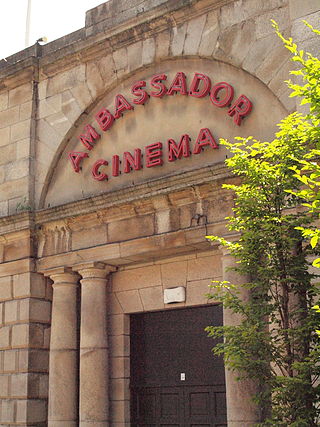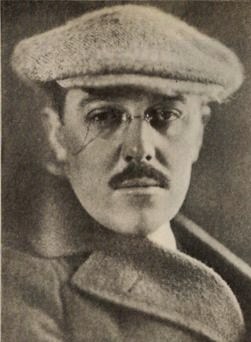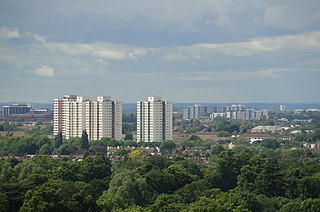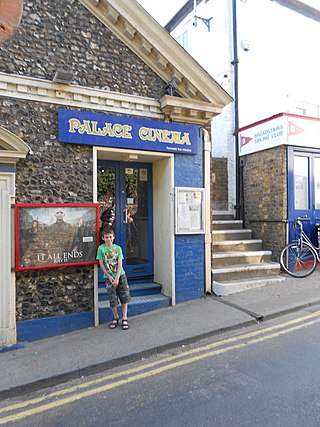
Hounslow is a large suburban district of West London, 10+3⁄4 miles west-southwest of Charing Cross. It is the administrative centre of the London Borough of Hounslow, and is identified in the London Plan as one of the 12 metropolitan centres in Greater London.

Isleworth is a town located within the London Borough of Hounslow in West London, England. It lies immediately east of the town of Hounslow and west of the River Thames and its tributary the River Crane. Isleworth's original area of settlement, alongside the Thames, is known as 'Old Isleworth'. The north-west corner of the town, bordering on Osterley to the north and Lampton to the west, is known as 'Spring Grove'.

The Odeon Luxe Leicester Square is a prominent cinema building in the West End of London. Built in the Art Deco style and completed in 1937, the building has been continually altered in response to developments in cinema technology, and was the first Dolby Cinema in the United Kingdom.
Odeon, stylised as ODEON, is a cinema brand name operating in the United Kingdom, Ireland and Norway, which along with UCI Cinemas and Nordic Cinema Group is part of the Odeon Cinemas Group subsidiary of AMC Theatres. It uses the famous name of the Odeon cinema circuit first introduced in Great Britain in 1930.

Heston and Isleworth was a local government district of Middlesex, England from 1894 to 1965.

The Ambassador Cinema was Dublin's longest-running cinema and was operational on and off until 1999. It operated as a music venue between 2001 and 2008. The Ambassador's current use is as an exhibition hall & event centre.
West Thames College is a medium-sized college of further and higher education in West London, England. It was formed in 1976, originally named Hounslow Borough College, having gained its current name in 1993. The college has two campuses in the London Borough of Hounslow: a main campus in Isleworth and a smaller Skills Centre in Feltham. As of 2014 there were over 5,200 enrolled students at the college. The college offers a wide range of A Levels and specialist vocational courses up to higher education level: BTECs, NVQs, City & Guilds, Foundation Degrees and HNDs.

The Dome Cinema, Worthing, West Sussex, England, is a grade II* listed building owned by PDJ Cinemas Ltd. The Dome Cinema, which has three screens and a Projectionist's Bar is run by PDJ Cinemas, while Alfresco Services run two function rooms and the cafe at the front of the building. It has closed for refurbishment several times, most recently between December 2005 and July 2007. The name derives from the distinctive dome on top of a three-storey tower over the entrance.
Green's Playhouse was an entertainment complex comprising a cinema, ballroom, tea rooms and other facilities. The Playhouse was at 126 Renfield Street, Glasgow, Scotland, commissioned by George Green Ltd, designed by the architect John Fairweather, and built by the Cinema Building Company. Opened in 1927, the Playhouse operated until the 1970s, a decline in audience numbers in the 1960s necessitated diversification as a music venue until closure in 1973. The building continued in use as the Apollo, after being acquired by Unicorn Leisure on a lease-holding arrangement, until final closure in 1985, with subsequent demolition in 1987.

Fred LeRoy Granville was born in Warrnambool, Victoria, Australia, in 1896, and educated in New Zealand. The 1 February 1922, issue of American Cinematographer stated that he was "a bloody Britisher by birth" and "first saw the light at Worton Hall, Isleworth, Middlesex, England." Granville became interested in photography as a boy. His first experience with cinematography came in 1913 under the guidance of James Crosby at the Selig Polyscope studio in Edendale, near downtown Los Angeles. Granville photographed the documentary Rescue of the Stefansson Expedition (1914) and a number of features and serials for Universal, including Liberty, A Daughter of the USA (1916) and The Heart of Humanity (1918). He also shot several of cowboy actor Tom Mix's early Fox features. The last two films he directed were produced in France.

The Capitol Theatre is a multi-purpose arts venue in Horsham, West Sussex, England.
The Odeon Haymarket was a cinema on Haymarket, London. Three cinemas occupied the site between 1925 and 1996, predecessors being Capitol Cinema (1925–1936) and Gaumont Haymarket (1937–1959). It became the Odeon Haymarket in 1962, before closing in 1996.

John Stanley Coombe Beard FRIBA, known professionally as J. Stanley Beard, was an English architect known for designing many cinemas in and around London.

Ivybridge, formerly Mogden, is a housing estate in the southern part of Isleworth in West London. Formerly agricultural, it was the site of Mogden Isolation Hospital, later South Middlesex Hospital, from 1897 to 1991.

The Odeon at Kingstanding, Birmingham, was a 1930s cinema in the Odeon chain. Though closed as a cinema in 1962, the building survives as a bingo hall, and is Grade II listed.

The Odeon Cinema, Manchester was a former Odeon Cinema located on Oxford Street, Manchester, England. It was close to St. Peter’s Square, within the Civic Quarter of Manchester city centre. It was demolished in April 2017, to be replaced by Landmark, a 14-storey office building, as part of a major transformation of the area.

Storyhouse is a large, mixed-use cultural building in Chester, England, which opened in May 2017. The complex includes a theatre, cinema, restaurant and the city library. It is housed in the remodelled 1936 Odeon Cinema, a grade-II-listed building, together with a newly built extension to hold the theatre auditorium.

The Ace Cinema, originally the Grosvenor Cinema and now known as the Zoroastrian Centre, is a Grade II* listed Art Deco former cinema in Rayners Lane in the London Borough of Harrow.

Staines Town Hall is a municipal building in the Market Square, Staines-upon-Thames, Surrey, England. The town hall, which briefly served as the headquarters of Spelthorne Borough Council, is a Grade II listed building.

The Palace Cinema is an independent single-screen cinema in Broadstairs, Kent, England. Housed in a converted commercial building, it opened in 1965 as the Windsor Cinema, and was renamed the Palace in 2006. It now shows mainly independent films. The Grade II listed building is in Harbour Street, close to the beach at Viking Bay.
















